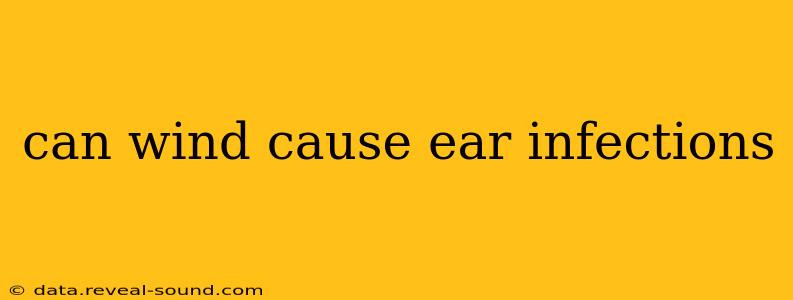The question of whether wind can directly cause ear infections is a common one, and the short answer is: no, wind itself doesn't cause ear infections. However, wind can play an indirect role in increasing your risk, making it a factor worth understanding. This article will explore the relationship between wind and ear infections, addressing common concerns and misconceptions.
How Does Wind Relate to Ear Infections?
While wind isn't the culprit itself, it can exacerbate existing conditions or create circumstances that make ear infections more likely. Think of it as a contributing factor rather than a direct cause. Here's how:
-
Increased Exposure to Cold Temperatures: Wind chill intensifies the effect of cold air on your body, including your ears. Exposure to cold can constrict blood vessels in your ears, potentially weakening your immune system's ability to fight off infections. This weakened immune response leaves you more susceptible to developing an ear infection, particularly if you're already prone to them.
-
Dust and Debris: Wind can carry dust, pollen, and other airborne particles into your ear canal. These irritants can trigger inflammation and create a breeding ground for bacteria or viruses, potentially leading to an ear infection. This is especially true for those with pre-existing ear conditions or compromised immune systems.
-
Drying Out the Ear Canal: Wind can dry out the delicate skin inside your ear canal. Dry skin is more susceptible to cracking, which can create entry points for bacteria or viruses. This dryness can also make the ear canal more susceptible to irritation and infection.
What Causes Ear Infections?
Understanding the true causes of ear infections is crucial to dispelling myths surrounding wind. Ear infections, medically known as otitis media (middle ear infection) or otitis externa (swimmer's ear), are primarily caused by:
-
Viruses: Viral infections are the most common cause of ear infections, especially in children. These viruses often cause inflammation and fluid buildup in the middle ear.
-
Bacteria: Bacterial infections can also lead to ear infections, often following a viral infection. Bacteria can thrive in the presence of fluid in the middle ear, causing a more serious infection.
-
Allergies: Allergies can contribute to inflammation in the ear and make the ear canal more susceptible to infection. Allergens like pollen, which can be windborne, can indirectly influence the risk.
-
Changes in Air Pressure: Changes in air pressure, such as those experienced during air travel or diving, can also contribute to ear infections by causing a temporary imbalance in the middle ear. This isn't directly related to wind but demonstrates how environmental factors can influence ear health.
Can Wind Make Existing Ear Problems Worse?
Yes, wind can certainly worsen existing ear conditions. If you already have an ear infection or a chronic ear problem such as eczema or a perforated eardrum, wind's drying effect and potential for carrying irritants can aggravate your symptoms and prolong recovery.
How to Protect Your Ears from Wind's Indirect Effects
Protecting your ears from the elements is a key step in preventing ear infections. Simple precautions can significantly reduce your risk:
-
Wear a hat or earmuffs in cold, windy weather. This helps to keep your ears warm and shielded from wind chill and airborne irritants.
-
Avoid exposure to extreme cold and wind as much as possible. Especially during cold and flu season, limit prolonged periods in windy, cold conditions.
-
Clean your ears regularly but gently. Avoid using cotton swabs, as these can push debris further into the ear canal.
In Summary: Wind and Ear Infections
While wind itself cannot cause ear infections, its indirect influence shouldn't be overlooked. Wind can create a more favorable environment for bacteria and viruses to thrive and worsen existing ear conditions. Understanding the true causes of ear infections and taking preventative measures is key to maintaining good ear health. If you experience persistent ear pain or discomfort, consult a healthcare professional for proper diagnosis and treatment.
